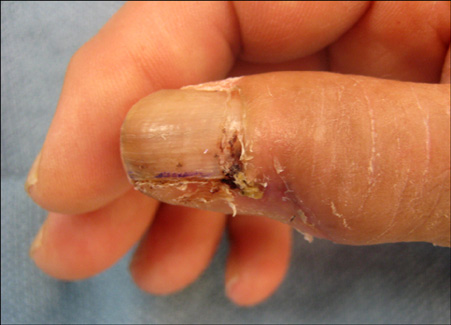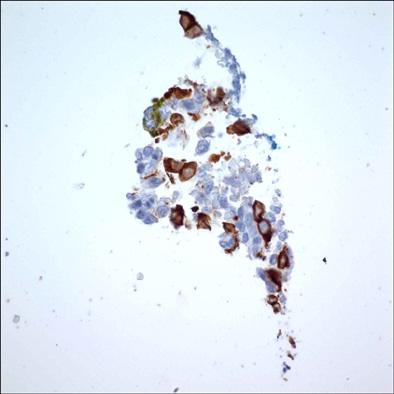Ann Dermatol.
2011 Dec;23(Suppl 3):S285-S287. 10.5021/ad.2011.23.S3.S285.
Perils of Diagnosis and Detection of Subungual Squamous Cell Carcinoma
- Affiliations
-
- 1Department of Surgery, Division of Plastic Surgery, UMDNJ-New Jersey Medical School, New Jersey, USA. fleeglea@umdnj.edu
- 2Department of Pathology and Laboratory Medicine, UMDNJ-New Jersey Medical School, New Jersey, USA.
- KMID: 2171852
- DOI: http://doi.org/10.5021/ad.2011.23.S3.S285
Abstract
- Subungual squamous cell carcinoma often presents with atypical clinical manifestations, which can lead to delays in diagnosis. The presence of a tumor can be masked by the presence of infections or other misleading pathological conditions. The authors report on techniques for adequate biopsy and excision of such tumors. A case of subungual squamous cell carcinoma with invasion into the underlying bone is presented. Clinical histopathological evidence is reviewed along with human papillomavirus typing. Accurate diagnosis requires a high index of suspicion and appropriate tissue sampling.
Keyword
MeSH Terms
Figure
Reference
-
1. Porembski MA, Rayan GM. Subungual carcinomas in multiple digits. J Hand Surg Eur Vol. 2007. 32:547–549.
Article2. High WA, Tyring SK, Taylor RS. Rapidly enlarging growth of the proximal nail fold. Dermatol Surg. 2003. 29:984–986.
Article3. Attiyeh FF, Shah J, Booher RJ, Knapper WH. Subungual squamous cell carcinoma. JAMA. 1979. 241:262–263.
Article4. Guitart J, Bergfeld WF, Tuthill RJ, Tubbs RR, Zienowicz R, Fleegler EJ. Squamous cell carcinoma of the nail bed: a clinicopathological study of 12 cases. Br J Dermatol. 1990. 123:215–222.
Article5. Stetsenko GY, McFarlane RJ, Chien AJ, Fleckman P, Swanson P, George E, et al. Subungual Bowen disease in a patient with epidermodysplasia verruciformis presenting clinically as longitudinal melanonychia. Am J Dermatopathol. 2008. 30:582–585.
Article6. Moy RL, Eliezri YD, Nuovo GJ, Zitelli JA, Bennett RG, Silverstein S. Human papillomavirus type 16 DNA in periungual squamous cell carcinomas. JAMA. 1989. 261:2669–2673.
Article7. Bogumill GP, Fleegler EJ. Tumors of the hand and upper limb. 1993. New York: Churchill Livingstone;147–149.8. Dalle S, Depape L, Phan A, Balme B, Ronger-Savle S, Thomas L. Squamous cell carcinoma of the nail apparatus: clinicopathological study of 35 cases. Br J Dermatol. 2007. 156:871–874.
Article9. Salasche SJ, Garland LD. Tumors of the nail. Dermatol Clin. 1985. 3:501–519.
Article10. Shapiro L, Baraf CS. Subungual epidermoid carcinoma and keratoacanthoma. Cancer. 1970. 25:141–152.
Article





